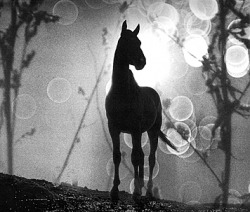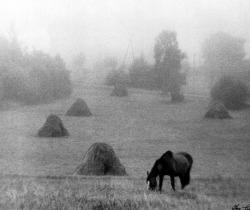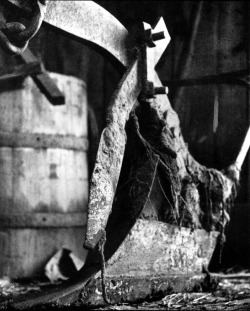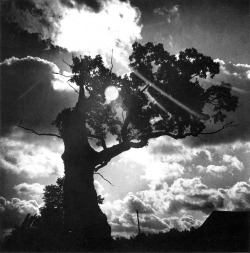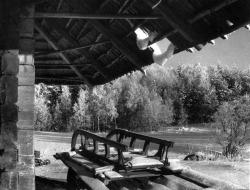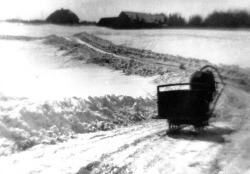A text to introduce non-Latvian readers to the work of Imants Puriņš (Imants Purins) (1930-2008), without prejudice to copyright.
Imants Purins
'Imants Purins (FIAP) was for many years Chairman of the Riga Photography Club and was known as a master of horse photos. Born in Veselava Parish, Cesis District, in 1930, Imants Purins made his debut as a photographer at an amateur exhibition at the Cesis Museum, and took an active part in founding the Cesis Photography Club. (...) Together with artistic director Aivars Āķis (Aivars Akis) he made Riga one of the leading creative centres of photographic art in the Soviet Union.(...) In 1987 Akis founded the Association of Photography Artists, which later grew into the Latvian Union of Photography Artists. (...) In the union Purins was first a member of the board and later Executive Secretary. Apart from carrying out his daily duties, Purins specialized in photographing horses. They were the theme closest to his heart up to the moment when, as he pointed out, he could no longer catch up with them. (...) His horse pictures decorated magazines, books, brochures, booklets and calendars ... and have been exhibited in many countries in more than 250 solo and group exhibitions, both international and local.
His works, classics in Latvian photography, display an interaction of the formal techniques of pictorial photography with a romantic and heartfelt view of traditional Latvian rural life.'
"The place where my parents, 80 years ago, built their house Puriņi, had belonged to my ancestors for more than two centuries. At the age of six, under the supervision of my grandma, I became a herds-boy. The early sunlit, dew-sprinkled mornings influenced me so strongly that, all my life, i have kept returning to my childhood paths with a camera to document them in pictures.
The birches, limes and oaks, once planted by me and my parents in the grove named after Karlis Ulmanis, have grown tall. The wonderful blossoming orchard has aged. For years no one has been erecting crop sheaves in autumn or sweet-smelling haystacks in summer. There are no signs of horse carts, sleds or any old tools. The old threshing-barns, granaries, bath-houses, centenarian oaks and groves have vanished.
My only consolation is that I have managed to photograph much of all that during my long professional life. For the generations to come my photos will be the only evidence of the times before me. Perhaps they will be able to value and save those for the future.
Right here my ancestors cleared woods and dug out tree stumps. Their lives were full of hardship. Purini farmstead was also built on cleared land, and as a child I used to play among the pits, where once tree stumps had been. This is why I love the land of my childhood, the land saturated with my ancestors' sweat from hard work. I value and understand how much labour and effort there is in their legacy, which today can only be viewed in my photos. Will this heritage be valued and preserved by our descendants?"
(Source of photos and translated text: October 2008 issue of the Foto Kvartals magazine).
His works, classics in Latvian photography, display an interaction of the formal techniques of pictorial photography with a romantic and heartfelt view of traditional Latvian rural life.'
"The place where my parents, 80 years ago, built their house Puriņi, had belonged to my ancestors for more than two centuries. At the age of six, under the supervision of my grandma, I became a herds-boy. The early sunlit, dew-sprinkled mornings influenced me so strongly that, all my life, i have kept returning to my childhood paths with a camera to document them in pictures.
The birches, limes and oaks, once planted by me and my parents in the grove named after Karlis Ulmanis, have grown tall. The wonderful blossoming orchard has aged. For years no one has been erecting crop sheaves in autumn or sweet-smelling haystacks in summer. There are no signs of horse carts, sleds or any old tools. The old threshing-barns, granaries, bath-houses, centenarian oaks and groves have vanished.
My only consolation is that I have managed to photograph much of all that during my long professional life. For the generations to come my photos will be the only evidence of the times before me. Perhaps they will be able to value and save those for the future.
Right here my ancestors cleared woods and dug out tree stumps. Their lives were full of hardship. Purini farmstead was also built on cleared land, and as a child I used to play among the pits, where once tree stumps had been. This is why I love the land of my childhood, the land saturated with my ancestors' sweat from hard work. I value and understand how much labour and effort there is in their legacy, which today can only be viewed in my photos. Will this heritage be valued and preserved by our descendants?"
(Source of photos and translated text: October 2008 issue of the Foto Kvartals magazine).
